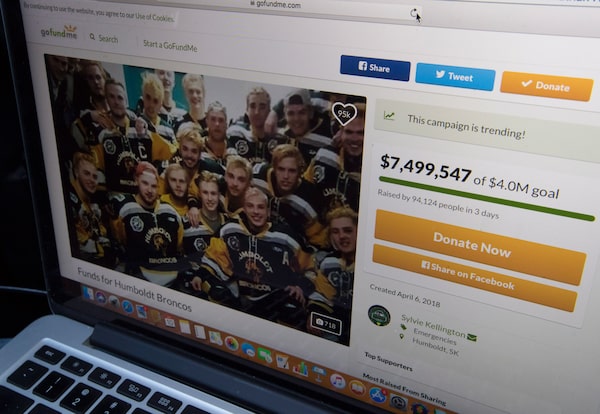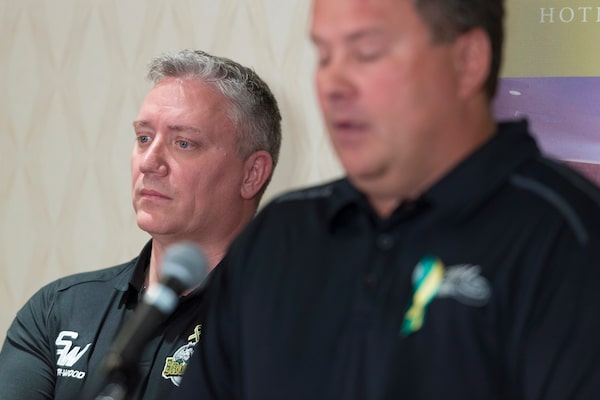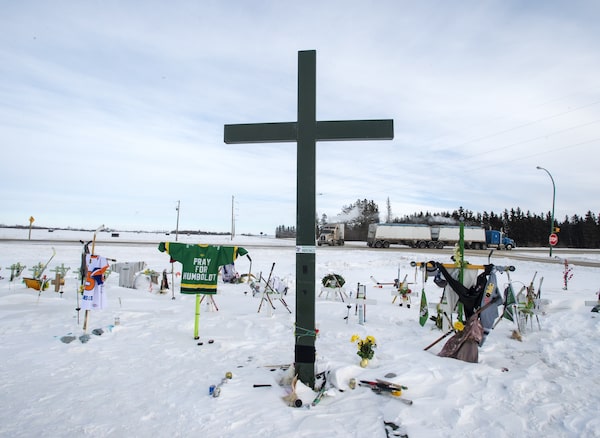Sylvie Kellington, left, and Cailin Hergott, the creators of the GoFundMe account for the the Humboldt Broncos crash victims at the Humboldt Art Gallery in Humboldt, Sask. on March 8, 2019.Kayle Neis/The Globe and Mail
Sylvie Kellington was at home in Humboldt, Sask., last year when word spread that the Broncos bus crashed. Devastating details followed.
“We are just a little town, and everyone knows everybody else here,” Ms. Kellington says. “I felt helpless.”
She is the mom of two teenagers and works as a hairstylist. Her son had only recently stopped playing hockey. Her heart ached for the parents and families of the 16 who died and the 13 survivors.
She exchanged messages with her friend, Cailin Hergott. Each desperately wanted to help.
“I sat on my couch thinking, ‘What can we do?’ ” Ms. Kellington says. “That’s when it dawned on me. I had heard of GoFundMe.”
She quickly used her phone to set up an account for the Broncos on the world’s largest online crowdfunding platform.
“Please help us raise money for the players and families affected,” she wrote simply. “Money will go directly to help with expenses incurred.”
Ms. Kellington hoped $10,000 could be raised.
She did not expect her act of kindness to evolve into something so complicated that the court system would be involved. She never expected a fortune to accrue, or that parents swamped with grief would fight over it. She could not foresee that advisers entrusted with dispensing the funds would receive threats from some families. The Globe and Mail reviewed several hundred pages of court documents detailing how the complex and emotional process unfolded.
Ms. Kellington envisioned a grassroots campaign. In the next 12 days, however, the fund grew to almost $15.2-million. It is by many times the largest amount ever raised in Canada through GoFundMe, and ranks among the most successful movements in the history of the decade-old U.S. company.
“I was grateful people responded the way they did, but I was overwhelmed,” Ms. Kellington says. “I didn’t know what to do.”
The outpouring of generosity was so rapid that in some cases the victims of the April 6 crash had not been identified yet.
“There was so much going on that money was the last thing people here were thinking about,” Ms. Kellington says. She is from Alberta, but has lived in Humboldt for seven years. “It was chaotic.”
The tragedy occurred as the Junior A-level hockey team was headed to a playoff game in a town two hours away. The chartered bus collided with a semi-tractor trailer after the driver of the truck ran a stop sign at a highway intersection. The crash killed 10 players between 16 and 21 years old, along with two coaches, the athletic therapist, the bus driver, a broadcaster and the team statistician, a high-school student on a job-shadowing assignment.
The truck’s driver, Jaskirat Singh Sidhu, faces a maximum of 14 years in prison when he is sentenced on March 22. He has pleaded guilty to 16 counts of dangerous driving causing death and 13 counts of dangerous driving causing bodily harm.
“I know how I felt, and I didn’t lose a family member,” Ms. Kellington says of the despair that gripped Humboldt. “I can barely remember the next week. People were numb.”
A reporter for a local radio station contacted her the next morning to inquire about the GoFundMe account. Ms. Kellington looked online and gasped.
“At that point, there was already $80,000 in it,” she says. “I started to freak out.”
As more donations rolled in, a reporter for The New York Times requested an interview. Ms. Kellington turned it down.
“Things were getting too intense,” she says.

A GoFundMe page for the Humboldt Broncos on April, 10, 2018. Days later, the fund grew to almost $15.2-million.JONATHAN HAYWARD/The Canadian Press
She called the Humboldt Broncos board of governors and asked it to take charge of the fund.
Team officials approached GoFundMe and consulted legal experts. As they conferred over days, 140,000 donations from $10 to $200,000 poured in from people in 87 countries.
On April 18, the Broncos board shut down the account. The $15.2-million was moved into a trust fund overseen by a Saskatoon law firm. At the same time, the board of governors established a separate charitable entity, the Humboldt Strong Community Foundation, to receive ongoing donations. Those funds are held in trust by a different law firm. Approximately $4.2-million has been received and will help anyone touched by the tragedy, from families to first responders to the community itself.
Early on, advice was solicited for the GoFundMe account from Kenneth Feinberg, the U.S. lawyer who presided over compensation funds for victims of the Sept. 11 terrorist attacks, the BP Deepwater Horizon disaster and the Boston Marathon bombings. He urged team officials to discharge the funds as quickly as possible.
From that point, it took eight months and multiple court appearances before the GoFundMe account was settled.
“If it was up to me, I would have just divided the money up 29 ways,” Ms. Kellington says.
It wasn’t up to her.
Three weeks after the bus crash, members of the team’s board of governors incorporated under the banner of the non-profit Humboldt Broncos Memorial Fund.
The law firm of MLT Aikins was retained on a pro-bono basis, and for the next several weeks the donated money was gradually transferred into its trust account.
A total of $14,641,989.18 was forwarded to MLT Aikins after GoFundMe deducted a payment of $482,712.48 and placed $48,499.97 in reserve to offset disputed donations. The crowd-funding site makes 30 cents per donation plus a processing fee of 2.9 per cent.
The board of directors of the Broncos Memorial Fund convened for the first time on May 8. At the meeting, it decided to proceed with the distribution of the GoFundMe account under supervision from the Court of Queen’s Bench of Saskatchewan. The case would be the first considered under provisions of the province’s new Informal Public Appeals Act.
The statute had been enacted in 2015 specifically to deal with legal issues that arise when funds are raised in a spontaneous public appeal. Saskatchewan is the only jurisdiction in Canada where the legislation exists.
“It put in place a process that brought about a bit of discipline,” says Jeffrey Lee of MLT Aikins, counsellor to the Broncos Memorial Fund. “Without it, the process would have been much more time-consuming. It would have taken years and years.”
Wary of a lawsuit due to the enormous amount of money involved, board members obtained an insurance policy with $10-million worth of coverage through a brokerage house in England.
Under guidelines of The Informal Public Appeals Act, Justice N.G. Gabrielson was assigned in July to supervise the distribution of funds.
The following month, Justice Gabrielson appointed a five-person advisory committee to recommend how the money should be allocated. The panel consisted of retired Court of Queen’s Bench Justice Dennis Ball, Winnipeg Jets team governor Mark Chipman, former Team Canada hockey star Hayley Wickenheiser, head and neck surgeon Peter Spafford and traumatic stress expert Kevin Cameron.
The advisers were chosen not only for their qualifications but also because they came from Alberta, Saskatchewan and Manitoba. Victims in the crash were from those three provinces.
“We wanted to find prominent Canadians whose background would demonstrate that they could take on this major responsibility in an effective manner,” says Kevin Garinger, one of the team officials who helped create and served on the board of the memorial fund. “We wanted to do the best we could for everybody.”
Catharsis and closure: Humboldt Broncos court proceedings come to an end
Last of 13 players injured in Humboldt Broncos bus crash released from hospital
Humboldt Broncos make SJHL playoffs nearly one year after devastating bus crash

Kevin Garinger, left, one of the team officials who helped create and served on the board of the memorial fund, said they wanted to do the best they could for everybody.Michael Bell/The Canadian Press
Three people were assigned to work with the advisory committee. Their job was to gather information about the financial needs of all 29 people aboard the bus by talking with the families.
This is where things took a turn down an unexpectedly complex, and at times dark, path.
The process was hindered by a small number of families that refused to provide financial or insurance information or estimates of any of the expenses they had incurred.
Most claimants took reasonable efforts to provide information. The circumstances made it challenging.
Many had not kept track of expenses and had yet to receive insurance benefits. Many survivors were still receiving medical treatment and unable to predict future needs.
The others were simply unwilling.
“A few claimants adopted a very different approach,” the committee reported in court documents. “They declined to provide any useful information … [and] declined to consent to disclosure of any of that information by insurers or other third parties.
“We concluded that our inquiry into ‘expenses incurred’ should be discontinued – not only because we received little or no information from some claimants, but because the quantity and quality of information we required was simply not available.”
On Sept. 7, the advisory committee asked MLT Aikins to go back to court to clarify whether the GoFundMe money was restricted to only being used to pay for beneficiaries’ expenses.
It had become clear to committee members that far more had been raised through GoFundMe than what was required for expenses. If donations could not be used for anything other than that, what would happen to the rest?
Although Ms. Kellington’s exact words in creating the account called for the money to be used to help with expenses, Justice Gabrielson believed it was a broader appeal.
On Oct. 16, he ruled that the funds did not have to be used specifically for expenses. He decided that they could be distributed in the form of non-compensatory payments or gifts.
As the advisory committee began to consider information gathered by its three aides, themes started to emerge. One was the notion that an equal amount should be allocated to all 29 families “as always intended.” The other was that the 29 families had feared their friendships would be ruined if unequal payments were made.
Between Oct. 30 and Nov. 6, the advisory panel conducted followup interviews with 15 families in person and nine by telephone.
The majority expressed a preference for the money to be divided 29 ways, but also recognized that some families might deserve more than others, and that too would be fair. The three dissenting families were insistent that the money be divided equally.
“Three claimants were entrenched in their position that the only choice open was to recommend an equal distribution to all 29 families,” the advisory committee wrote in a court document. “Each of the three claimed to speak for all other families. Two went so far as to suggest that unless the committee recommended an equal distribution, the reputations of its members would be ruined.
“We accept that each of the three claimants believe in the rightness of their position. That said, we did not find their relatively aggressive approach to be helpful. Their comments did not influence our recommendations, but they did provide insight into the pressure to conform felt by many families.”
The committee was apprehensive that people had been coerced.
“Whether or not some claimants have intentionally pressured others to conform, a significant number feel the pressure of group dynamics,” the advisers wrote in the court document. “Some are emotionally fragile and do not have the capacity to openly state how they feel or advocate for themselves.
“A number of families feel that they have been more adversely affected than the survivors and their families. We believe that the opportunity to share their reality with us was not motivated by monetary considerations. Rather, what they seek is some recognition that the lives of their loved ones had as much or more value as the lives of the injured survivors.”
All of the survivors were players. The advisory committee also conferred with them and their families. Even the most gravely injured recommended that the survivors should all share equally. Their parents said their worries were not monetary.
“What we need is prayers, not money,” one told the committee.
On Nov. 10, the committee sent its recommendations to the board members of the Humboldt Bronco Memorial Trust Fund.
It realized no amount of money would replace the loved ones lost. It understood that survivors with permanent injuries would never choose any amount of money over the ability to live the life they once had.
“In our view, the fundamental problem with an equal division is that the circumstances of beneficiaries are not equal,” the advisory committee said in its recommendation. “The first and foremost difference is that 16 of 29 passengers died, leaving loved ones with profound grief, anguish and depression. The depths of despair is unfathomable.
“The other 13 passengers have their life. Some have their health. Their families can celebrate their survival and take pride in their accomplishments. There is a huge difference in emotional circumstances between most of the families who lost a loved one and most of the families who did not.”

A memorial at the crash site in Tisdale, Sask.Ryan Remiorz/The Canadian Press
Ultimately, the advisory committee recommended that the families of the 16 people who died should receive $525,000 each, and that each of the 13 survivors should receive $475,000.
“We have considered the logic and fairness of our recommendations by asking two simple questions,” it wrote. “First, would any of the 13 survivors and their families trade places with any of the other 16 families in return for any amount of money? Of course, they would not. Second, would any of the 16 families who have lost a loved one forego any amount of money if they could have their sons, daughter, or partners back? Of course they would, in a heartbeat.”
The board of the Humboldt Broncos Memorial Fund supported the decision, and sent it to Justice Gabrielson. On Nov. 28, in a courtroom in Saskatoon, he approved it.
“The simplicity and the reasonableness of the recommendation appeals to me,” Justice Gabrielson said.
Chris and Andrea Joseph have visited the site of the bus crash three times. They are likely to go there again later this month after Mr. Sidhu is sentenced.
Their son, Jaxon, was a 20-year-old member of the Broncos. On Sept. 15, Jaxon’s birthday, his parents brought 21 balloons to the memorial beside the highway and wrote a message on his cross.
Mr. Joseph, an Edmonton firefighter and former player for the National Hockey League Oilers, says he and his wife are still struggling. “We are doing better, but there are still days where it kicks you between the eyes.”
He was slightly disappointed with the advisory committee’s resolution. He hoped that the GoFundMe money would be disbursed in 29 equal payments.
“The advisory committee was put in an impossible position,” Mr. Joseph says. “I think they tried to do the best and fairest thing they could. Over all, I think they did a very good job.”
Attempts were made to reach members of the advisory committee. Justice Ball, the panel’s chairman, responded by e-mail. He described the discussions with family members as emotionally challenging.
“We decided that it would serve the best interests of the families if we allowed our report to speak for itself,” the retired judge wrote. “We also agreed that declining all comment would be the best way to preserve the confidentiality of our communications with the families.”
Scott Thomas and his wife Laurie are using a portion of the $525,000 to set up a memorial trust that will fund three university scholarships each year in their son’s name.
Evan Thomas, 18, was finishing his rookie season with the Humboldt Broncos when the crash occurred.
“Among the 29 families and parents, opinions of what to do were all over the map,” Mr. Thomas says. “Thank God there was somebody there to give it sober second thought. We were all too emotionally invested to make an objective decision.
“Without the committee, there would have been pure chaos.”
Ms. Kellington and her friend Ms. Hergott are happy the process is over.
“Nothing can undo what happened, but we’re glad we got involved and we are glad it helped families,” Ms. Hergott says. “We just started the account, and then the world took over."
 Marty Klinkenberg
Marty Klinkenberg